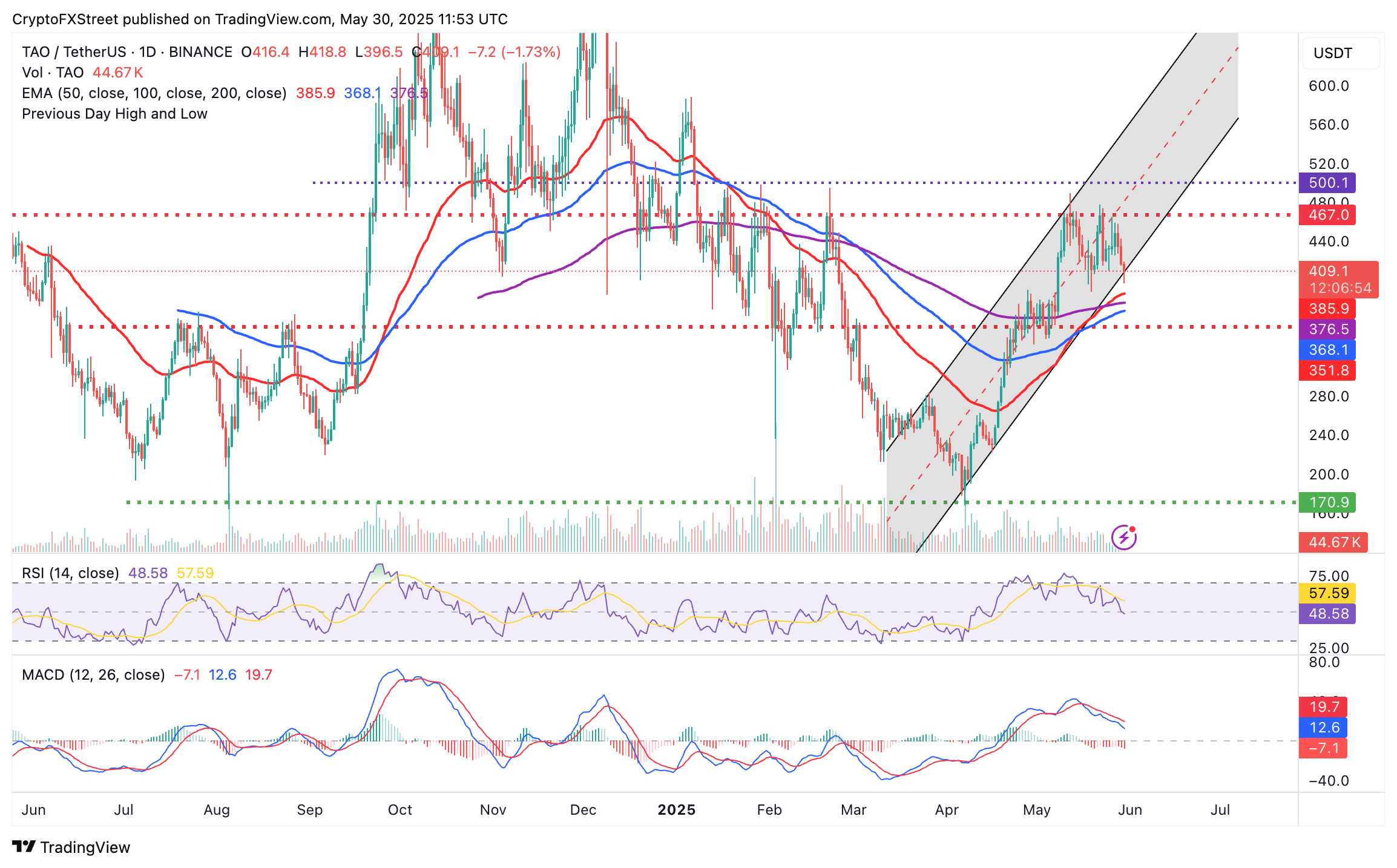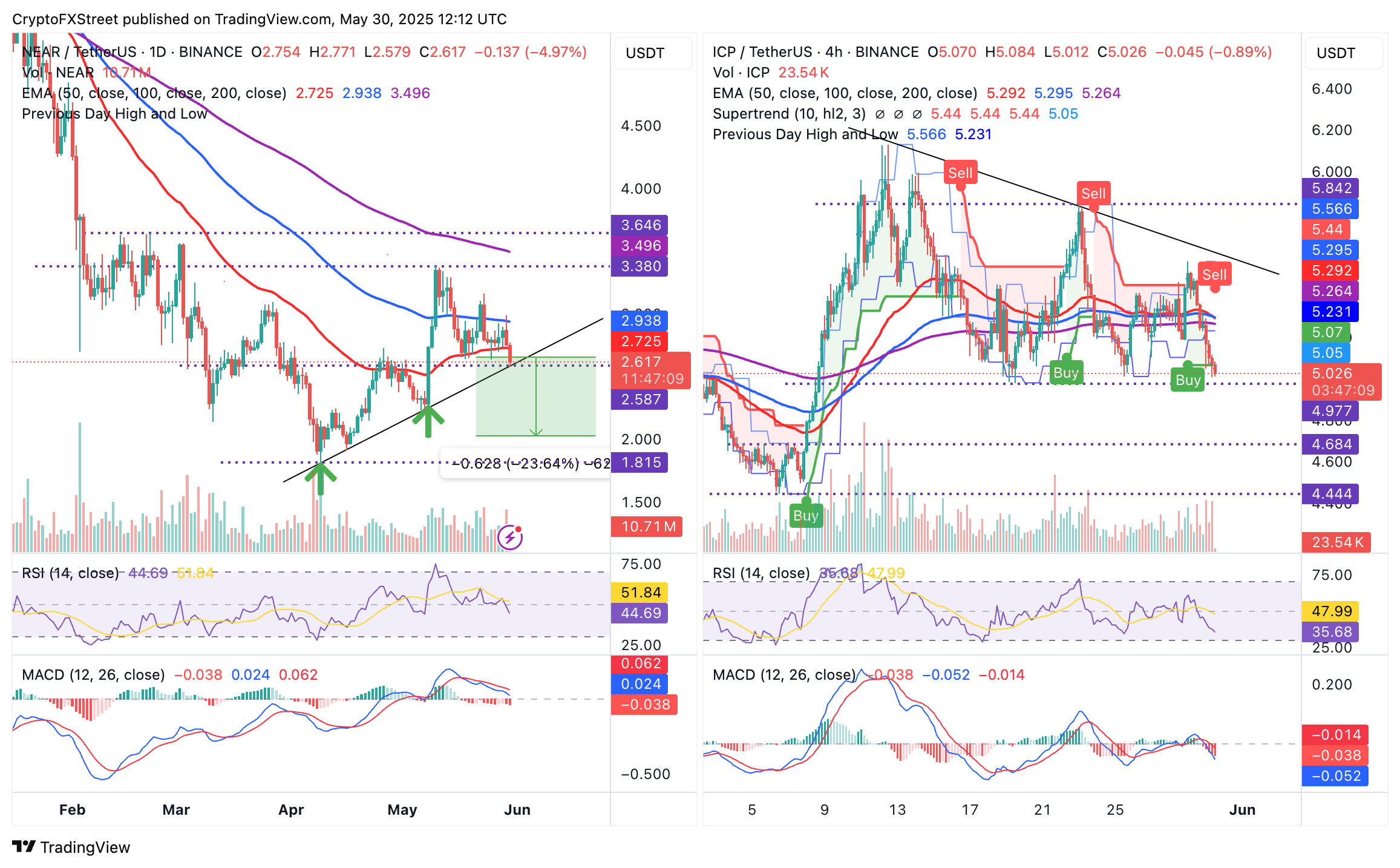Top AI tokens Bittensor, NEAR, ICP flip bearish as uncertainty surrounding US tariffs bites
- The cryptocurrency market claws back mid-week gains amid US tariff uncertainty.
- Bittensor bulls fight to defend $400 support and the broader trend within an ascending channel.
- Near Protocol's higher lows pattern in jeopardy as the price drops below 100-day and 50-day moving averages.
- Internet Computer downside vulnerability in focus as the MACD indicator signals bearish momentum.
The crypto market is mainly in the red on Friday, characterized by losses sustained over the past 24 hours after a United States (US) appeals court stayed the ruling that had blocked President Donald Trump's tariffs.
Leading Artificial Intelligence (AI) tokens, including Bittensor (TAO), Near Protocol (NEAR) and Internet Computer (ICP), showcase weakness alongside major assets such as Bitcoin (BTC), Ethereum (ETH) and Ripple (XRP).
Market overview: Volatility spikes amid tariff uncertainty
A federal court of appeals stayed the ruling that had nullified President Donald Trump's tariffs on Wednesday at the request of the Justice Department.
The ruling by the Court of International Trade said that the US Constitution grants Congress exclusive power to regulate trade with other countries and that this authority cannot be overridden by the President's emergency powers to safeguard the economy.
President Trump's tariffs will continue, at least for now, adding another layer of uncertainty. The focus could also shift to the reciprocal tariffs announced in April but delayed for 90 days to allow for negotiations. As the negotiation window narrows, doubt could creep in, spooking investors.
The Federal Reserve (Fed) has in the recent past warned that tariffs could have a lasting impact on the economy, particularly on inflation, despite President Trump calling for urgent interest rate cuts.
The release of the Personal Consumption Expenditure (PCE) Price Index data later on Friday could be a catalyst for high volatility heading into the weekend. This data on inflation offers cues into the general direction of Fed policy, especially on interest rates.
Bittensor, NEAR, ICP technical outlook: What's next as prices tumble
The intersection of AI technology with blockchain continues to garner significant attention, with tokens such as Bittensor, Near Protocol, and Internet Computer standing out. These three tokens combined account for nearly 33% of the crypto AI sector's market capitalization, which currently stands at $29 billion.
The largest AI token, Bittensor, boasts a market capitalization of approximately $3.6 billion. Powering the open-source protocol, which utilizes blockchain technology to create a decentralized machine learning network, is the native token TAO.
TAO hovers at around $408 at the time of writing, down almost 2% on the day. The uptrend within the ascending channel on the daily chart is under immense pressure. Should losses accelerate into the weekend, below the immediate $400 support, the path of least resistance will stay downward.
Notably, TAO sits above key moving averages, such as the 50-day Exponential Moving Average (EMA), the 100-day EMA, and the 200-day EMA, which are likely to offer support and absorb selling pressure. Key areas of interest on the upside include the supply zone around $467, which was tested as resistance on May 24, May 12, and in February, as well as the $500 level that was tested in January and December.

TAO/USDT daily chart
NEAR, the token powering the Near Protocol's high-performance blockchain for AI, decentralized applications, and intelligent agents, has lost almost 22% of its value following the recent rally to $3.38.
NEAR sits below the 200-day EMA currently at $3.49, the 100-day EMA at $2.93 and the 50-day EMA at $2.72. A higher low pattern, illustrated by the ascending trendline on the chart below, is at risk of breaking, which could accelerate losses. Key levels traders could pay attention to are the $2.00 area, 23% below the current market rate, and April's low around $1.81.

NEAR/USDT daily chart and ICP/USDT 4-hour chart
Meanwhile, Internet Computer's price is defending support at $5.00, following a sharp drop from the recent lower high of $5.56. The path of least resistance appears downward, underpinned by a sell signal from the Moving Average Convergence Divergence (MACD) indicator.
This signal occurred on Thursday when the blue MACD line crossed below the red signal line, encouraging traders to sell ICP and contributing to the selling pressure. Beyond the support at $5.00, traders should pay attention to the areas around $4.68 and $4.44, which were tested as resistance and support in early May.
Cryptocurrency prices FAQs
Token launches influence demand and adoption among market participants. Listings on crypto exchanges deepen the liquidity for an asset and add new participants to an asset’s network. This is typically bullish for a digital asset.
A hack is an event in which an attacker captures a large volume of the asset from a DeFi bridge or hot wallet of an exchange or any other crypto platform via exploits, bugs or other methods. The exploiter then transfers these tokens out of the exchange platforms to ultimately sell or swap the assets for other cryptocurrencies or stablecoins. Such events often involve an en masse panic triggering a sell-off in the affected assets.
Macroeconomic events like the US Federal Reserve’s decision on interest rates influence crypto assets mainly through the direct impact they have on the US Dollar. An increase in interest rate typically negatively influences Bitcoin and altcoin prices, and vice versa. If the US Dollar index declines, risk assets and associated leverage for trading gets cheaper, in turn driving crypto prices higher.
Halvings are typically considered bullish events as they slash the block reward in half for miners, constricting the supply of the asset. At consistent demand if the supply reduces, the asset’s price climbs.

